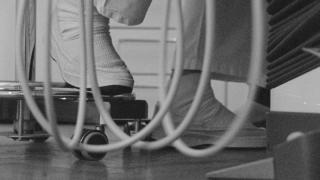Heavy Metal Detox as an aesthetic paraphrase on the removal of amalgam dental fillings. The procedure - mirrored from spiritual, sarcastic, existential and nihilistic perspectives - condenses into a cantata in film format.
Heavy Metal Detox
A 2019, 35mm / DCP / HD Video (Super 16mm footage), b/w, sound, 12 min
Director, Script, Editing and Production: Josef Dabernig
Camera: Christian Giesser
Music: Christoph Herndler
Sound design: Michael Palm
Cast: Kristina Balcanovic, Josef Dabernig, Cornelia Schintlmeister, Josef Schintlmeister
Funding: if innovative film Austria at the Federal Chancellery of Austria, Arts and Culture Division, Film Department and Cultural Department of the City of Vienna (MA7)
Synopsis
production note
Heavy Metal Detox versteht sich als ästhetische Paraphrase auf die Entfernung von Amalgamplomben. Die zahntechnische Maßnahme verdichtet sich im spirituell-, sarkastisch-, existenziell- und nihilistisch gefärbtem Licht zu einer Kantate im Filmformat.
Produktionsnotiz
Josef Dabernig's films are always highly calculated, based on a meticulously detailed script. In a self-reflexive move, he is also turning his attention to the mechanical side of life and its absurdly scripted elements. Traffic regulations and slot machines, routine cleaning and fitness monotony in his films reveal the deeply comical character of our existence, in ironical accordance with the famous Henri Bergson's theory of mechanical as the source of the comical. In "Heavy Metal Detox", the dental drilling machine and a highly precise order of medical procedures, are one of these comical devices, with an important twist: here, the artist himself is undergoing the treatment, which means that he has to surrender control. Not completely (the film is still carefully edited), but enough to evoke the humility of humans confronted to the powerful higher force, here of a mighty dental surgeon. It is from his perspective (unknown to most of mere mortals unless they are dentists themselves) that we are watching the film.
The procedure was linked to Dabernig's medical condition of that year that required, among other things, the replacement of all of his amalgam filling. Here, the human body is added new spare parts, repaired like a mechanism or even updated like software. With this, the body is also cleaned from disease remnants. The very modernist dialectics of the "purified" and the "non-purified" (that we could also call "real") is at the core of many Dabernig's films. He is never deserting the awkwardness of the Real in favor of the artistic perfection of the Pure; in his films, they often quarry and struggle in a hilarious way. Here, for instance, Christoph Herndler’s organ music that "elevates" the scene is subtly mixed with real construction site noises, compressors and drills.
Ekaterina Degot, sixpackfilm catalogue
Reviews
... My first program in the bold Wavelengths section was a short and feature paired together due to their opposite approaches—hard and soft—to close-ups of hands doing work and the satisfaction the audience gets from different kinds of tactility. It began with the hard: the pleasingly shrill and satisfyingly materialist Heavy Metal Detox, a short film by Austrian artist Josef Dabernig. Essentially documenting a procedure of dental surgery, in swiftly cut and crisply graded 16mm black and white we see close-up fragments of just about everything—tools, mouth, hands, gloves, teeth—as what seems like a cleaning soon turns to more invasive work. The face of the patient and those of the doctor and assistants are kept off camera, so that the bare inventory and facts of the experience are emphasized: this item, that action; cold steel and wet gums. Unless anyone in the audience is a dentist, we are as in the dark as to what is happening as the patient is, head back and unable to see what’s next. Patient, or victim? The soundtrack predictably, but no less gratifyingly, fulfills our expectations for grating tactility. If you’ve ever been under any of these tools, you’ll get goosebumps. Flourishes of organ-sounding music is cut in intermittently with faux-grandiose spirit and wry humor, confirming the tone of this as comic horror. A shot of an X-ray gives away the game, deepens the performance: The patient is Dabernig himself, subjected as much to the dentist’s tools as he is to his own analytic decoupage. Artistic creation as tortuous surgery, painfully necessary excavation, a film built as the body is taken apart. The great mystery: How on earth did he “direct” while anesthetized? ...
Daniel Kasman
https://mubi.com/de/notebook/posts/toronto-correspondences-4-the-momento..., 09 Sept 2019
Heavy Metal Detox (Josef Dabernig, Austria) [bonus review]
In recent years, there has been considerable interest in the intersection of experimental cinema and horror. A lot of this was occasioned by work coming out of Austria, birthplace of Freud and the uncanny, and perhaps not coincidentally the locus of some pretty bracing stuff in the avant-garde art world. There's the Viennese Aktionists, of course, with their ritual bloodletting and headlong dive into primitive regression. And, as if to make that irrationalist work even more frightening, you often had highly rigorous filmmakers such as Peter Kubelka, Kurt Kren, and Valie Export, providing a hyper-mathematical shape to animal slaughter and bodily functions. Probably the most famous avant-horror film is Peter Tscherkassky's Outer Space, a found footage nightmare using scenes from The Entity. In Tscherkassky's film, Barbary Hershey is menaced not just by a sexually aggressive ghost, as in the original film, but by the breakdown of the celluloid itself.
This is perhaps the best context in which to understand Josef Dabernig's latest film Heavy Metal Detox. In certain respects, it is a brief documentary about Dabernig's trip to the dentist. But in its fragmentation, pacing, and editing, and its skillful orchestration of the seen and the unseen, Heavy Metal Detox is an experience to quite literally set your own teeth on edge. As profound an example of body-horror as anything Cronenberg could cook up, but more disturbing because of its palpable excavation into real-world flesh and bone, Heavy Metal Detox explores not just the discomfort of an elaborate procedure (the removal of metal fillings and their replacement with durable plastics), but the viewer's fear of being in the chair. The film ramps up anxiety rather than soothing it.
We know intellectually that Dabernig is receiving good care. But Heavy Metal Detox emphasizes his helplessness at the hands of unseen technicians who invade the body with tools and devices. The soundtrack alternates between ominous tones and the harsh sound of the drill. And the contrast the film sets up between the cold, white, antiseptic spaces of the dentists' office and its equipment, on the one hand, and the moist, dark expanse of Dabernig's mouth, on the other, is deeply unnerving. In a way, it reminds us of a paradox at the heart of this medical phobia. Like those earlier Austrian experimentalists, Dabernig is setting up a dialectic between the dirty and the clean, and our bodies are the dirty. The "horror" lives inside of us.
Michael Sicinski
https://mubi.com/de/notebook/posts/toronto-wavelengths-shorts-lives-of-p..., 10 Sept 2019



